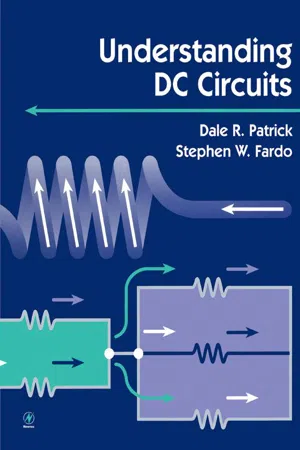
- 255 pages
- English
- ePUB (mobile friendly)
- Available on iOS & Android
Understanding DC Circuits
About This Book
Understanding DC Circuits covers the first half of a basic electronic circuits theory course, integrating theory and laboratory practice into a single text. Several key features in each unit make this an excellent teaching tool: objectives, key terms, self-tests, lab experiments, and a unit exam.
Understanding DC Circuits is designed with the electronics beginner and student in mind. The authors use a practical approach, exposing the reader to the systems that are built with DC circuits, making it easy for beginners to master even complex concepts in electronics while gradually building their knowledge base of both theory and applications. Each chapter includes easy-to-read text accompanied by clear and concise graphics fully explaining each concept before moving onto the next. The authors have provided section quizzes and chapter tests so the readers can monitor their progress and review any sections before moving onto the next chapter. Each chapter also includes several electronics experiments, allowing the reader to build small circuits and low-cost projects for the added bonus of hands-on experience in DC electronics.
Understanding DC Circuits fully covers dozens of topics including energy and matter; static electricity; electrical current; conductors; insulators; voltage; resistance; schematic diagrams and symbols; wiring diagrams; block diagrams; batteries; tools and equipment; test and measurement; series circuits; parallel circuits; magnetism; electromagnetism; inductance; capacitance; soldering techniques; circuit troubleshooting; basic electrical safety; plus much more.
- Integrates theory and lab experiments
- Contains course and learning objectives and self-quizzes
- Heavily illustrated
Frequently asked questions
Information
Basics of DC Electronics
Important Terms
Table of contents
- Cover image
- Title page
- Table of Contents
- Copyright page
- Preface
- Course Objectives
- Parts List for Experiments
- Unit 1: Basics of DC Electronics
- Unit 2: Measuring Voltage, Current, and Resistance
- Unit 3: Ohm’s Law and Electric Circuits
- Unit 4: Magnetism and Electromagnetism
- Unit 5: Electronic Instruments
- Unit 6: Inductance and Capacitance
- Appendix A: Electronic Symbols
- Appendix B: Electric Safety
- Appendix C: Electronic Equipment and Parts Sales
- Appendix D: Soldering Techniques
- Appendix E: Troubleshooting
- Index